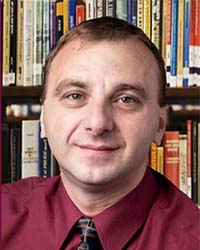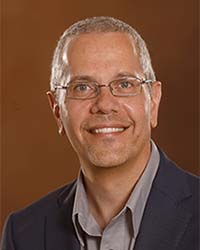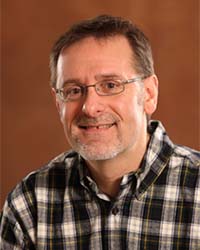Inorganic Chemistry
Pioneering research in inorganic chemistry
At Central Michigan University, our Inorganic Chemistry program offers dynamic research opportunities that blend advanced materials science, innovative synthesis techniques, and state-of-the-art instrumentation. Students and researchers are immersed in hands-on discovery, exploring the behavior, properties, and design of metals, minerals, and organometallic compounds. Our faculty lead high-impact research across a range of applications—from energy storage to catalysis—preparing students for success in graduate programs, national laboratories, and the chemical industry.
Research focus areas and faculty expertise
Dr. Gabriel Caruntu
Designing functional nanomaterials for next-generation technologies
 Dr. Caruntu’s research group focuses on the rational design and synthesis of functional nanomaterials for cutting-edge applications in energy storage and conversion, environmental sensing, heterogeneous catalysis, and spintronics. By leveraging principles of colloidal chemistry, molecular self-assembly, and surface engineering, the group fabricates nanostructures with tailored morphology, internal architecture, and chemical composition. These include nanocrystals, nanotubes, nanorods, and thin films with controllable topologies, enabling targeted functionality at the nanoscale.
Dr. Caruntu’s research group focuses on the rational design and synthesis of functional nanomaterials for cutting-edge applications in energy storage and conversion, environmental sensing, heterogeneous catalysis, and spintronics. By leveraging principles of colloidal chemistry, molecular self-assembly, and surface engineering, the group fabricates nanostructures with tailored morphology, internal architecture, and chemical composition. These include nanocrystals, nanotubes, nanorods, and thin films with controllable topologies, enabling targeted functionality at the nanoscale.
Dr. Bradley D. Fahlman
Advanced nanostructured materials for energy storage
 The Fahlman group conducts advanced research in the development and electrochemical evaluation of nanostructured carbon-based materials, including mesoporous carbons, graphene derivatives, and silicon-carbon hybrids. These materials are engineered for high-performance energy storage devices, including lithium-ion, sodium-ion, and metal-air batteries, as well as supercapacitors. The group employs both liquid-phase and vapor-phase synthetic techniques, such as chemical vapor deposition (CVD) and atomic layer deposition (ALD), and utilizes an extensive suite of analytical tools (SEM, TEM, XRD, AFM, XPS, IR, UV-Vis, Raman). Electrochemical testing is carried out with high-precision equipment, including Princeton Applied Research potentiostats and a 384-channel Maccor battery analyzer housed in a controlled glovebox environment.
The Fahlman group conducts advanced research in the development and electrochemical evaluation of nanostructured carbon-based materials, including mesoporous carbons, graphene derivatives, and silicon-carbon hybrids. These materials are engineered for high-performance energy storage devices, including lithium-ion, sodium-ion, and metal-air batteries, as well as supercapacitors. The group employs both liquid-phase and vapor-phase synthetic techniques, such as chemical vapor deposition (CVD) and atomic layer deposition (ALD), and utilizes an extensive suite of analytical tools (SEM, TEM, XRD, AFM, XPS, IR, UV-Vis, Raman). Electrochemical testing is carried out with high-precision equipment, including Princeton Applied Research potentiostats and a 384-channel Maccor battery analyzer housed in a controlled glovebox environment.
Dr. Philip Squattrito
Unveiling molecular structures through x-ray crystallography
 Dr. Squattrito’s research emphasizes the use of single-crystal X-ray crystallography to explore the three-dimensional structures of inorganic and organic compounds, with the aim of correlating structural features to their chemical and physical behavior. Current studies involve multi-dimensional metal sulfonate frameworks and organic molecules capable of releasing nitric oxide, a biologically relevant signaling molecule. Many compounds are synthesized in-house or through collaboration with external labs, contributing to interdisciplinary research with biomedical and materials science relevance.
Dr. Squattrito’s research emphasizes the use of single-crystal X-ray crystallography to explore the three-dimensional structures of inorganic and organic compounds, with the aim of correlating structural features to their chemical and physical behavior. Current studies involve multi-dimensional metal sulfonate frameworks and organic molecules capable of releasing nitric oxide, a biologically relevant signaling molecule. Many compounds are synthesized in-house or through collaboration with external labs, contributing to interdisciplinary research with biomedical and materials science relevance.
Join a community of discovery
The Inorganic Chemistry program at CMU is built on a foundation of research excellence, hands-on learning, and faculty mentorship. Whether you are an undergraduate seeking research experience or a graduate student aiming to contribute to transformative scientific breakthroughs, our program offers the resources and expertise to support your goals. Join us as we explore the frontiers of materials chemistry, pushing the boundaries of what’s possible at the atomic and molecular level.
